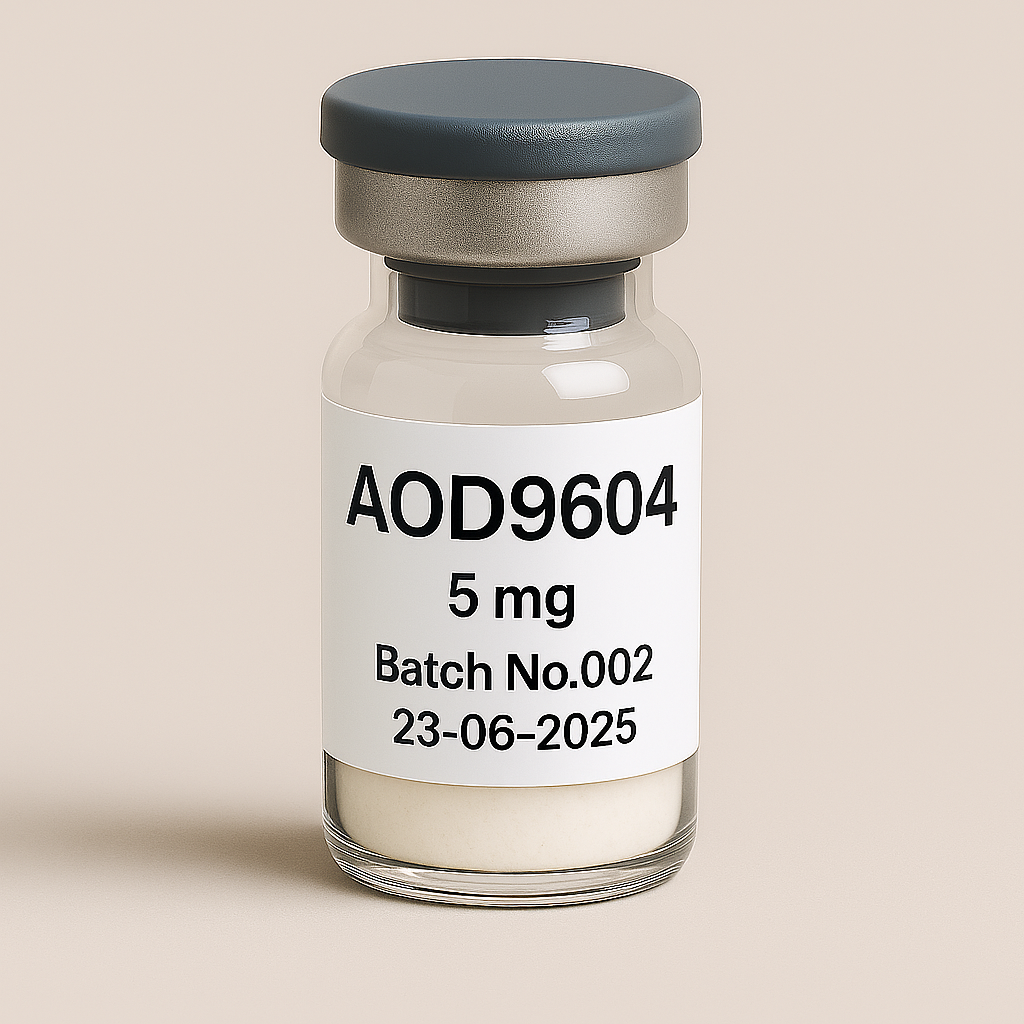
AOD9604 5mg vial
Pickup currently not available
NOT FOR HUMAN CONSUMPTION
AOD9604 is a synthetic peptide fragment derived from the C-terminal region (amino acids 177–191) of human growth hormone (hGH), with an additional N-terminal tyrosine residue. Originally developed for obesity management, AOD9604 aims to replicate the lipolytic (fat-reducing) effects of hGH without its associated anabolic (growth-promoting) actions. Despite initial promise, its clinical development has faced challenges, and it remains unapproved by major regulatory agencies.
2. Mechanism of Action
AOD9604 is designed to stimulate lipolysis and inhibit lipogenesis, thereby promoting fat breakdown and preventing fat accumulation. Its mechanisms include:
-
Activation of β3-Adrenergic Receptors: AOD9604 appears to enhance lipolysis by upregulating β3-adrenergic receptors in adipose tissue. Studies in obese mice have shown that AOD9604 increases β3-AR expression, leading to enhanced fat metabolism. However, its lipolytic effects are diminished in β3-AR knockout mice, suggesting a critical role for these receptors .
-
Independence from IGF-1 and Glucose Metabolism: Unlike full-length hGH, AOD9604 does not significantly affect insulin-like growth factor 1 (IGF-1) levels or glucose metabolism, reducing the risk of hyperglycemia and insulin resistance .
3. Clinical Efficacy
3.1. Preclinical Studies
In animal models, AOD9604 has demonstrated:
-
Weight Reduction: Obese Zucker rats treated with AOD9604 showed a significant reduction in body weight gain compared to controls. The peptide enhanced lipolytic activity in adipose tissues without adverse effects on insulin sensitivity .
-
Enhanced Fat Metabolism: Chronic administration in obese mice led to increased expression of β3-AR and improved lipid metabolism, supporting its potential as a fat-reducing agent .
3.2. Human Clinical Trials
-
12-Week Trial: In a randomized, placebo-controlled trial, subjects receiving 1 mg/day of AOD9604 experienced an average weight loss of 2.6 kg, compared to 0.8 kg in the placebo group. The treatment was well-tolerated with no significant adverse effects .
-
24-Week Trial: A subsequent larger study involving 536 subjects did not demonstrate significant weight loss compared to placebo, leading to the discontinuation of its development for obesity treatment .
4. Safety and Tolerability
AOD9604 has been generally well-tolerated in both animal and human studies:
-
Non-Genotoxic and Non-Toxic: Comprehensive toxicological assessments, including Ames tests and chromosomal aberration assays, revealed no genotoxic or toxic effects. Chronic administration in rats and monkeys showed no adverse outcomes .
-
Minimal Side Effects: Clinical trials reported minimal side effects, with no significant impact on IGF-1 levels, glucose metabolism, or insulin sensitivity .
5. Additional Therapeutic Potential
Beyond weight management, AOD9604 has shown potential in other areas:
-
Cartilage Regeneration: In a study involving osteoarthritic rabbits, intra-articular injections of AOD9604, alone or combined with hyaluronic acid, led to improved cartilage morphology and reduced histopathological damage. This suggests potential applications in joint repair and osteoarthritis treatment .
-
Cellular Regeneration: In vitro studies indicate that AOD9604 may promote the differentiation of mesenchymal stem cells into bone and muscle cells, as well as enhance proteoglycan and collagen production in chondrocytes, supporting tissue repair processes .
6. Regulatory Status and Availability
-
Regulatory Approval: AOD9604 is not approved by the U.S. Food and Drug Administration (FDA) or other major regulatory bodies for any therapeutic use. Its development for obesity treatment was discontinued due to insufficient efficacy in clinical trials.
-
Current Use: Despite the lack of approval, AOD9604 is available through some compounding pharmacies and wellness clinics, often marketed for weight loss and anti-aging purposes. However, its use in these contexts is off-label and lacks robust clinical validation.
7. Conclusion
AOD9604 is a synthetic peptide that mimics the fat-reducing effects of hGH without its growth-promoting actions. While preclinical studies and early clinical trials showed promise in weight management and tissue regeneration, subsequent larger trials failed to demonstrate significant efficacy, leading to the cessation of its development for obesity treatment. Its safety profile appears favorable, but the lack of regulatory approval and comprehensive clinical data limits its therapeutic application. Further research is needed to fully elucidate its potential benefits and mechanisms of action.
References:
-
Heffernan M, et al. The effects of human GH and its lipolytic fragment (AOD9604) on lipid metabolism following chronic treatment in obese mice and beta(3)-AR knock-out mice. Endocrinology. 2001;142(12):5182-9.
-
Ng FM, et al. Metabolic studies of a synthetic lipolytic domain (AOD9604) of human growth hormone. Horm Res. 2000;53(6):274-8.
-
Obesity Pharmacotherapy: Current Perspectives and Future Directions. Frontiers in Endocrinology. 2013;4:73.
-
Safety and Tolerability of the Hexadecapeptide AOD9604 in Humans. Journal of Endocrinology and Metabolism. 2013;3(1-2):7-15.
-
Effect of Intra-articular Injection of AOD9604 with or without Hyaluronic Acid in a Rabbit Model of Osteoarthritis. Annals of Clinical & Laboratory Science. 2015;45(4):426-432.
-
AOD 9604 Peptide: Research in Lipolysis, Cell Regeneration, and Cancer. Core Peptides. 2024


